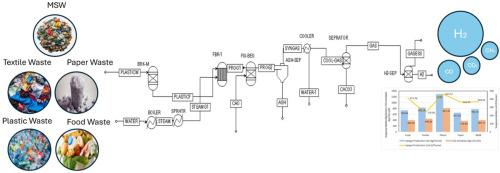Techno-economic and environmental evaluation of hydrogen production from municipal solid waste via CaO-assisted gasification for biorefinery applications
IF 5.8
2区 生物学
Q1 AGRICULTURAL ENGINEERING
引用次数: 0
Abstract
Climate change and GHG emissions are driving the shift from fossil fuel refineries to biorefineries, with biomass and waste playing a key role in this transition. The objective of this study is to evaluate the use of organic waste sources, especially municipal solid waste (MSW), for H2 production with economic potential. A process model in Aspen Plus v14® was used to study CaO-assisted gasification of five wastes (food, paper, textile, plastic, and MSW) under 650–900 °C and 500–2000 kg/h steam flow, with a fixed CaO-to-feed ratio of 1. Plastic waste demonstrated the highest hydrogen yield (up to 189.6 kg/h at 2000 kg/h steam), attributed to its higher hydrocarbon content and low oxygen ratio. The integration of CaO effectively captured over 50 % of the generated CO2, significantly enhancing syngas purity and hydrogen production through equilibrium shifts, particularly via the water-gas shift reaction. From a techno-economic perspective, plastic waste presented the lowest syngas production cost ($236.86/tonne) and highest annual net profit ($3.20 million), considerably outperforming biomass-derived feedstocks. MSW also showed favorable economics, indicating its viability as a feedstock due to its mixed composition. Environmentally, biomass-based feedstocks (paper, food waste, textile) yielded lower CO2 emissions (378.89–449.66 kg CO2-e/hr), highlighting their biogenic carbon neutrality benefits. Conversely, plastic waste exhibited the highest CO2 emissions (815.41 kg CO2-e/hr), underscoring a trade-off between economic performance and environmental impact. This research shows a promising, sustainable waste-to-fuel solution supporting biorefineries and the circular economy.

城市固体废物生物炼制中cao辅助气化制氢的技术经济和环境评价
气候变化和温室气体排放正在推动从化石燃料炼油厂向生物炼油厂的转变,而生物质和废物在这一转变中发挥着关键作用。本研究的目的是评估利用有机废物来源,特别是城市固体废物(MSW)生产氢气的经济潜力。利用Aspen Plus v14®中的过程模型,研究了在650-900℃、500-2000 kg/h蒸汽流量、固定草料比为1的条件下,草料辅助气化5种废弃物(食品、纸张、纺织品、塑料和城市生活垃圾)的过程。由于其较高的碳氢化合物含量和较低的氧比,塑料废物表现出最高的氢气产量(在2000千克/小时蒸汽下高达189.6千克/小时)。CaO的集成有效地捕获了50%以上产生的二氧化碳,通过平衡转换,特别是通过水气转换反应,显著提高了合成气纯度和氢气产量。从技术经济角度来看,塑料废物的合成气生产成本最低(236.86美元/吨),年净利润最高(320万美元),大大优于生物质原料。城市生活垃圾也表现出良好的经济效益,表明由于其混合成分,它作为原料是可行的。在环境方面,生物质原料(纸张、食物垃圾、纺织品)产生的二氧化碳排放量较低(378.89-449.66千克二氧化碳-e/小时),突出了其生物碳中和效益。相反,塑料垃圾的二氧化碳排放量最高(815.41 kg CO2-e/hr),强调了经济绩效和环境影响之间的权衡。这项研究显示了一个有前途的、可持续的废物转化为燃料的解决方案,支持生物炼制和循环经济。
本文章由计算机程序翻译,如有差异,请以英文原文为准。
求助全文
约1分钟内获得全文
求助全文
来源期刊

Biomass & Bioenergy
工程技术-能源与燃料
CiteScore
11.50
自引率
3.30%
发文量
258
审稿时长
60 days
期刊介绍:
Biomass & Bioenergy is an international journal publishing original research papers and short communications, review articles and case studies on biological resources, chemical and biological processes, and biomass products for new renewable sources of energy and materials.
The scope of the journal extends to the environmental, management and economic aspects of biomass and bioenergy.
Key areas covered by the journal:
• Biomass: sources, energy crop production processes, genetic improvements, composition. Please note that research on these biomass subjects must be linked directly to bioenergy generation.
• Biological Residues: residues/rests from agricultural production, forestry and plantations (palm, sugar etc), processing industries, and municipal sources (MSW). Papers on the use of biomass residues through innovative processes/technological novelty and/or consideration of feedstock/system sustainability (or unsustainability) are welcomed. However waste treatment processes and pollution control or mitigation which are only tangentially related to bioenergy are not in the scope of the journal, as they are more suited to publications in the environmental arena. Papers that describe conventional waste streams (ie well described in existing literature) that do not empirically address ''new'' added value from the process are not suitable for submission to the journal.
• Bioenergy Processes: fermentations, thermochemical conversions, liquid and gaseous fuels, and petrochemical substitutes
• Bioenergy Utilization: direct combustion, gasification, electricity production, chemical processes, and by-product remediation
• Biomass and the Environment: carbon cycle, the net energy efficiency of bioenergy systems, assessment of sustainability, and biodiversity issues.
 求助内容:
求助内容: 应助结果提醒方式:
应助结果提醒方式:


